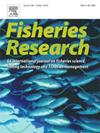Implementation of PIT-tags influence spatial distribution but not burst and hiding performance of a freshwater fish
IF 2.2
2区 农林科学
Q2 FISHERIES
引用次数: 0
Abstract
Tagging techniques, such as electronic transmitters and Passive Integrated Transponders (PIT-tags), are commonly used to monitor individuals to gather data on migration routes, habitat preferences, interactions with the environment, as well as movements in both natural and laboratory settings. However, concerns about the impact of tagging on animal welfare and behavior have been raised. This study aimed to evaluate retention rates to intramuscular and intraperitoneal tag implantation locations in chubs (Squalius cephalus). We also quantified effects of intramuscular PIT-tags on swimming performance, exploratory behavior, movement complexity and hiding behavior (in a behavioral arena), as well as stress indicators. Our study demonstrates that intramuscular PIT-tagging implementing allow a higher retention rate (97.5 %) compared to peritoneal injection (78.6 %). This result is lower than in other studies, which might be linked to species-specific differences, or colder water preventing healing and thus reinforcing tag loss. Additionally most of the measured behavioral variables did not show significant differences between intramuscularly tagged and untagged individuals. Tagged individuals still expressed reduced positioning at the center of the behavioral arena 3 weeks after tagging. This result suggests that the implantation of pit-tag could potentially affect exploration behavior and spatial distribution of fish in their environment in the short term. Longer-term effects should be considered but, according to our findings, intramuscular tagging appears to be a more reliable option for studies prioritizing long-term data collection. One may take into account the effects of these tags when computing fine-scale behavioral assessments, or should consider alternative methods.
pit标签的实施影响淡水鱼的空间分布,但不影响其爆发和隐藏性能
标记技术,如电子发射器和无源综合应答器(PIT-tags),通常用于监测个体,以收集迁徙路线、栖息地偏好、与环境的相互作用以及自然和实验室环境中的活动数据。然而,标签对动物福利和行为的影响也引起了人们的关注。本研究旨在评估在头角鲨(Squalius cephalus)肌肉和腹腔内植入标签位置的保留率。我们还量化了肌内pit标签对游泳表现、探索行为、运动复杂性和隐藏行为(在行为舞台上)以及压力指标的影响。我们的研究表明,与腹膜注射(78.6% %)相比,肌内pit标记实施具有更高的保留率(97.5 %)。这一结果比其他研究的结果要低,这可能与物种特异性差异有关,或者更冷的水阻止愈合,从而加强了标签的丢失。此外,大多数测量的行为变量在肌肉注射标记和未标记的个体之间没有显着差异。被标记的个体在标记3周后仍然表现出在行为舞台中心的位置减少。这一结果表明,植入坑标签可能会在短期内影响鱼类在其环境中的探索行为和空间分布。应该考虑长期影响,但根据我们的研究结果,肌肉注射标签似乎是优先考虑长期数据收集的研究更可靠的选择。当计算精细尺度的行为评估时,可以考虑这些标签的影响,或者应该考虑替代方法。
本文章由计算机程序翻译,如有差异,请以英文原文为准。
求助全文
约1分钟内获得全文
求助全文
来源期刊

Fisheries Research
农林科学-渔业
CiteScore
4.50
自引率
16.70%
发文量
294
审稿时长
15 weeks
期刊介绍:
This journal provides an international forum for the publication of papers in the areas of fisheries science, fishing technology, fisheries management and relevant socio-economics. The scope covers fisheries in salt, brackish and freshwater systems, and all aspects of associated ecology, environmental aspects of fisheries, and economics. Both theoretical and practical papers are acceptable, including laboratory and field experimental studies relevant to fisheries. Papers on the conservation of exploitable living resources are welcome. Review and Viewpoint articles are also published. As the specified areas inevitably impinge on and interrelate with each other, the approach of the journal is multidisciplinary, and authors are encouraged to emphasise the relevance of their own work to that of other disciplines. The journal is intended for fisheries scientists, biological oceanographers, gear technologists, economists, managers, administrators, policy makers and legislators.
 求助内容:
求助内容: 应助结果提醒方式:
应助结果提醒方式:


